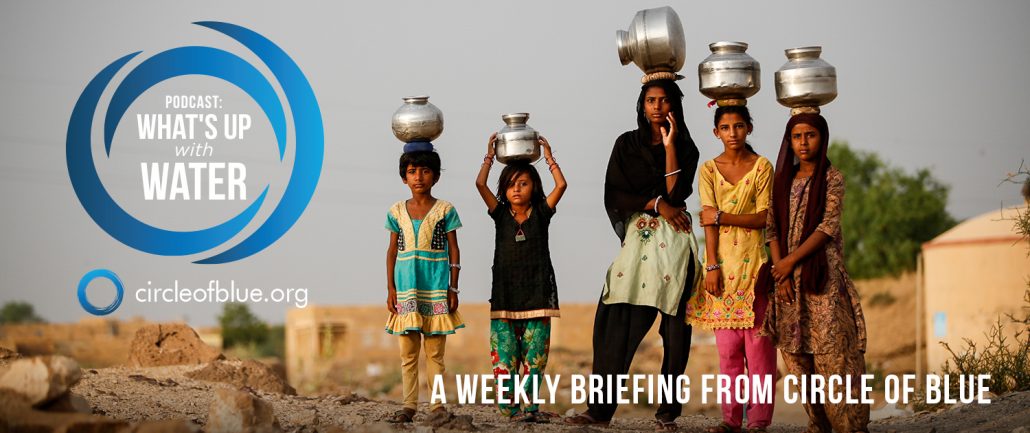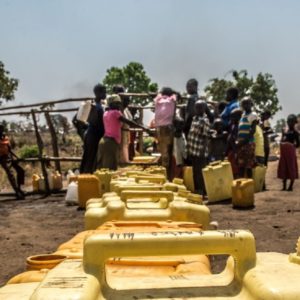This week’s edition of What’s Up With Water includes coverage on:
– Weakening water circulation in the Atlantic Ocean
– A cholera outbreak in Malawi
– Plans for boosting desalination in Israel
– The most endangered river in the United States
Transcripts
What’s Up With Water for April 16, 2018
I’m Eileen Wray-McCann, for Circle of Blue, and here’s What’s Up with Water, a condensation of the world’s water news.
Water circulation in the Atlantic Ocean has slowed to its weakest recorded level, and global warming is the likely cause – that’s according to a new study in the journal Nature. Researchers are seeing the weakening firsthand, and they warn that it could mean more extreme weather across the Northern Hemisphere, especially in Europe. It could also raise sea levels along the United States’ East Coast.
Circulating water in the Atlantic serves as a kind of a heat exchange for the planet. Warm, salty water moves north from the tropics via the Gulf Stream off the U.S. East Coast to the North Atlantic, where it cools, sinks and then moves south. The faster the process, the more water is cycled from the warmer surface to the cooler depths.
This exchange plays a key role in weather and climate. Atmospheric modeling programs have predicted its decline, and now the Atlantic’s circulation is the lowest in about 1,500 years. The Northern U.S. Atlantic coastal waters have warmed faster than most parts of the ocean in the last few decades and the Gulf Stream has changed its contours, which may in turn affect hurricanes.
Scientists say that global warming affects ocean circulation in various ways. It heats the ocean’s waters so there is less cool water to sink and motivate the cycle. Salinity plays a role as well: as ice melts in Greenland, a vast amount of fresh water enters the ocean and, because it is less dense than salt water, it sinks less, thus slowing the cycle. Disturbances in precipitation and evaporation further alter the balance that drives the circulation system.
The study, from Germany’s Potsdam Institute for Climate Impact Research, says the decrease in water circulation raises the possibility of a total circulation shutdown with catastrophic effects. A co-author of the study said it was unclear how far or near such a tipping point could be, calling the situation “uncharted territory.”
Malawi’s Ministry of Health last week said that cholera continues to claim lives in the southern African country, bringing the number of dead to 30 since March. Nearly 900 cases of cholera have been reported so far, blamed on contaminated drinking water. Flash flooding in the capital city, Lilongwe, has polluted shallow water sources, which are also threatened by the heavy rain that continues in most parts of the country.
Israel is responding to a five-year drought with plans for more desalination plants and an expanded pipeline grid. Years of dry conditions have reduced Israel’s natural water resources to their lowest levels in 100 years, and its existing desalination and wastewater treatment systems cannot keep up with the demand.
Its fertile land in the north is at risk, and both agriculture and the environment are stressed.
Israel’s water ministry announced plans to build two more desalination plants to add to the five that have been put along the Mediterranean coast over the past 13 years. Plans also include expanding the nation’s pipeline system, and pumping less from natural springs in order to restore rivers. There is even talk of sending massive amounts of water to the struggling Sea of Galilee, which is actually a lake near the Syrian border that serves as Israel’s prime freshwater source.
The water ministry intends to present the plans for government approval in the near future. The Middle East is particularly vulnerable to climate change, and competition for scarce water is a flashpoint for conflict and a driver of migration.
The Big Sunflower River, a tributary of the Mississippi, has earned the dubious distinction of the nation’s most endangered river of 2018 from the environmental organization American Rivers. Last week, the group called attention to the Big Sunflower River and 200 thousand acres of surrounding wetlands that are threatened by a large-scale agricultural drainage project.
The Yazoo Backwater Area Pumping Plant is a project that was first proposed by the U.S. Army Corps of Engineers in 1941. It was supposed to protect farmland from flooding between the Mississippi and Yazoo rivers, with one of the largest pumping stations ever built.
Critics, including the U.S. Fish and Wildlife Service, called it a waste of money and destructive to the environment. It would have damaged wetlands in two wildlife refuges and a national forest. After decades of controversy, the project was vetoed by the EPA in 2008 under the Clean Water Act.
The pumping project had been promoted for years by U.S. Senator Thad Cochran, a Mississippi Republican. Just before his retirement, as chairman of the Senate Appropriations Committee, Cochran added language to the Senate’s 2018 initial Omnibus bill ordering the project to be built “immediately and without delay or administrative or judicial review.” Estimates put the price of the project at $300 million in federal funds. The Yazoo Pumps language did not appear in the final appropriations bill, but the American Rivers group warns that some in Congress and in the Trump administration are pushing for the project. Environmental groups are keeping an eye on the farm bill, which is currently in the works. As the Trump administration rolls back EPA regulations, the president has suggested rescinding the agency’s authority to use the Clean Water Act to veto projects.
Cochran’s office says that the pumping project will protect land and people and save taxpayers money. Opponents argue that the advantages are overstated and that the project would mostly benefit a small number of landowners and contractors, at great cost to the public and the environment. They advocate for healthy wetlands and floodplains as a better way to manage increased stormwater and flooding.
Additional source used:
https://www.clarionledger.com/story/news/politics/2018/04/10/mississippis-big-sunflower-river-named-nations-most-endangered-2018/482096002/
And that’s What’s Up With Water…We’d like to share what’s up where you are – Tweet us with your water news: @circleofblue #whatsupwithwater.
Eileen Wray-McCann is a writer, director and narrator who co-founded Circle of Blue. During her 13 years at Interlochen Public Radio, a National Public Radio affiliate in Northern Michigan, Eileen produced and hosted regional and national programming. She’s won Telly Awards for her scriptwriting and documentary work, and her work with Circle of Blue follows many years of independent multimedia journalistic projects and a life-long love of the Great Lakes. She holds a BA and MA radio and television from the University of Detroit. Eileen is currently moonlighting as an audio archivist and enjoys traveling through time via sound.





